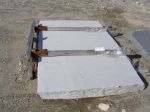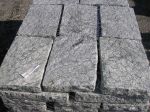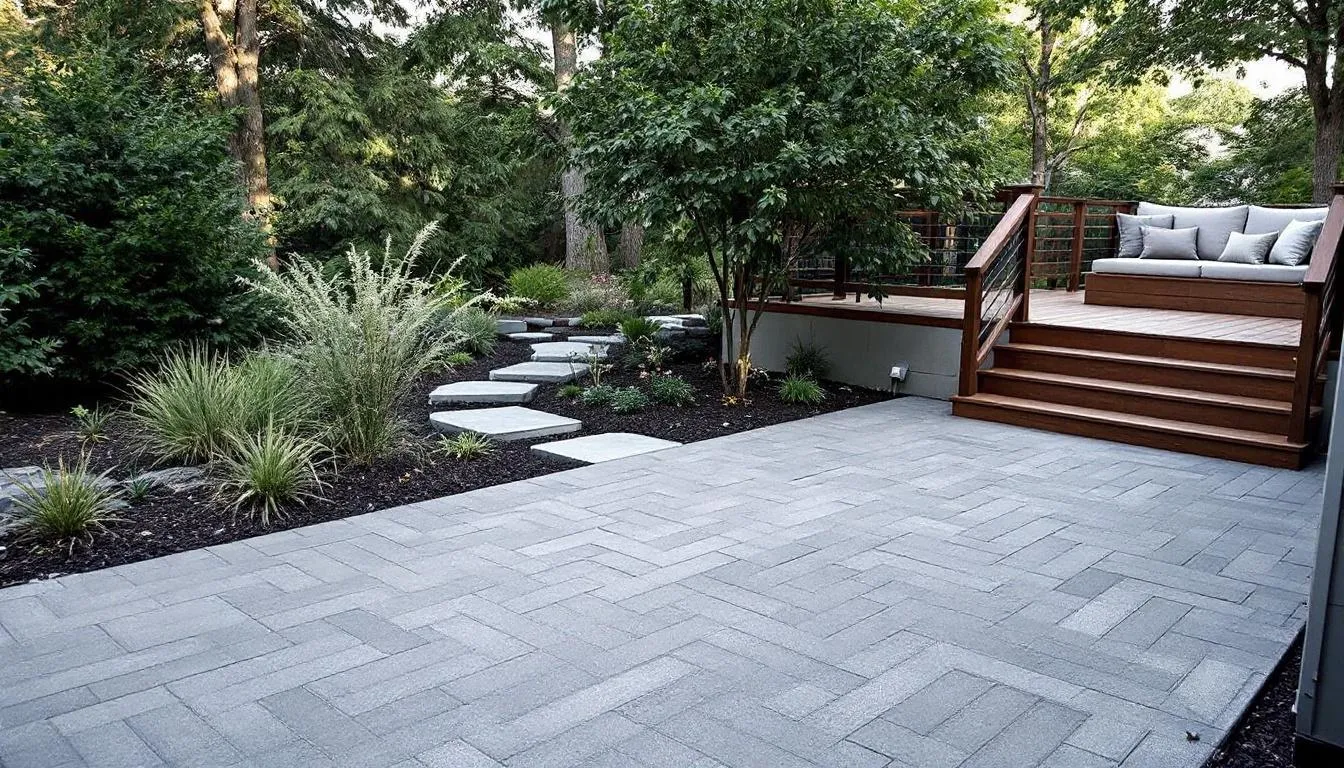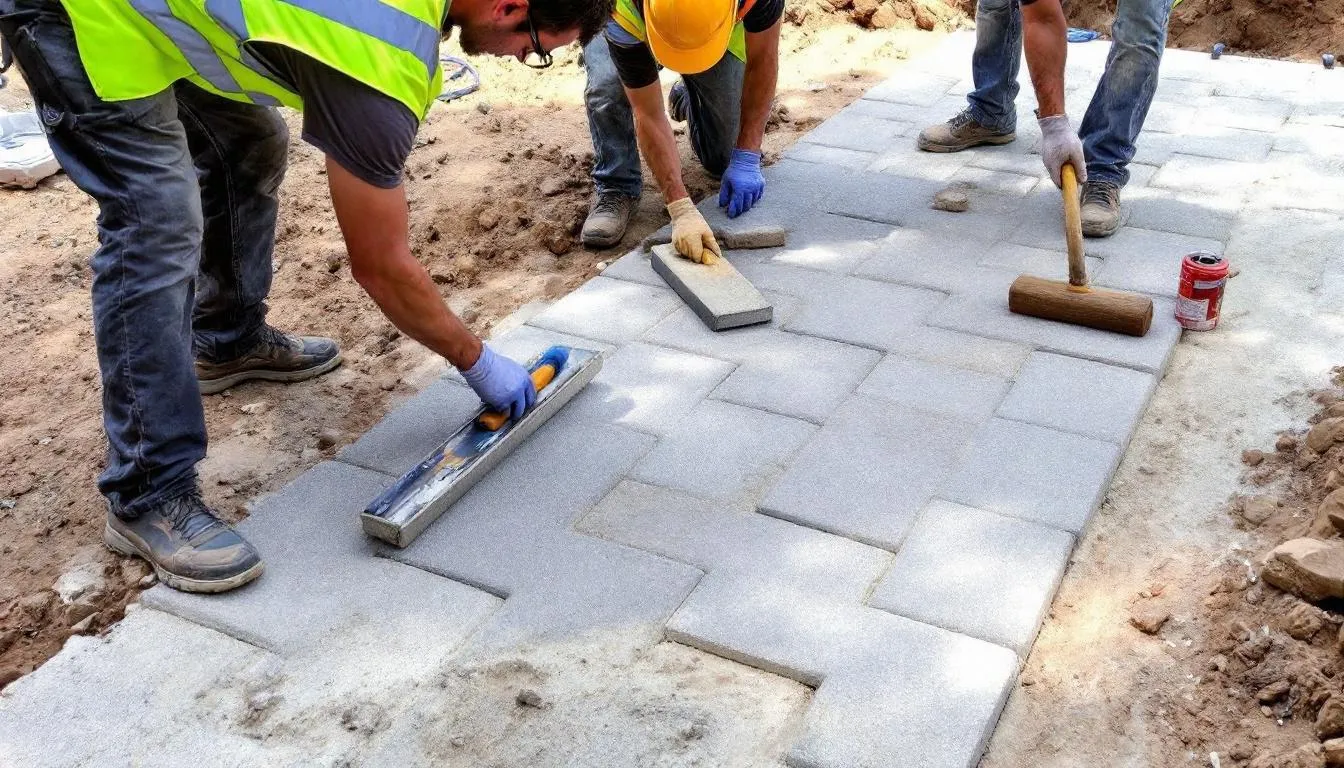Ready to Order?
For a quick answer on pricing or stock, give us a call at 508-622-1698.
Or, if you prefer, simply fill out the short form below with your quantity, location, name, phone number, and email. We’ll get back to you with a detailed quote during business hours.
The Complete Guide to Granite Pavers: Transform Your Outdoor Space with Natural Stone
Granite pavers represent the pinnacle of natural stone paving materials, offering unmatched durability and timeless elegance for outdoor spaces. These natural stone products are engineered from granite—a coarse-grained igneous rock formed through slow crystallization of magma deep beneath the Earth’s surface. When you choose granite pavers for your project, you’re investing in one of the oldest stones known to builders, with the inherent ability to withstand decades of use while maintaining its original beauty.
What Are Granite Pavers and Why Choose Them?
Granite pavers are precision-cut slabs of natural granite, primarily composed of quartz, feldspar, and mica. This crystalline structure creates the material’s exceptional strength and distinctive speckled appearance that architects and designers have valued for centuries. Unlike fabricated materials, each paver carries unique natural variations that occur during the stone’s formation process, ensuring your outdoor space has character that cannot be replicated.
The benefits of granite extend far beyond aesthetics. With a compressive strength of approximately 200 MPa and density ranging from 2.65 to 2.75 g/cm³, granite stands as the most durable choice among natural stone pavers. This strength translates to real-world performance: granite pavers can handle vehicular traffic, resist chipping under heavy loads, and maintain their structural integrity through countless freeze thaw cycles.
When comparing materials, granite consistently outperforms alternatives. Concrete pavers, while less expensive initially, require frequent sealing and are affected by surface wear within years. Granite’s low porosity (less than 0.5%) makes it naturally resistant to water absorption, eliminating many maintenance concerns that plague other paving materials. This inherent resistance means granite pavers are a better choice for climates with harsh winters, where freeze-thaw cycles can destroy lesser materials.
Types and Specifications of Granite Pavers
Modern quarrying methods allow installers to offer granite pavers in various sizes and configurations. Standard dimensions include 12”x12”, 18”x18”, and 24”x24”, with large pavers extending up to 36”x48” for dramatic installations. Extra large pavers create a sense of spaciousness in patios and walkways while reducing the number of joints that require maintaining.
Thickness options typically include 1.25” pavers for pedestrian areas and 2” versions for driveways and spaces that must support heavier loads. The finish significantly affects both appearance and functionality. Flamed finishes provide enhanced slip resistance for pool areas, while honed surfaces offer smooth elegance for formal patios. Natural cleft finishes preserve the stone’s rustic character, creating authentic textures that complement natural landscaping.
Color variations reflect the earth’s geological diversity. Popular choices include Dove White granite with subtle grey veining, Midnight Granite for dramatic contrast, and regional favorites like Eastern Gray that blend with local stone traditions. These natural colors remain consistent over decades, unlike painted or stained materials that fade under UV exposure.
Planning Your Granite Paver Project
Successful granite paver installations begin with thorough planning. Whether creating a new patio, redesigning walkways, or covering driveways, proper preparation determines both immediate results and long-term performance. Start by measuring your space accurately—granite’s precision cutting means you can plan layouts with minimal waste.
Design considerations should account for granite’s natural variations. While each paver maintains consistent dimensions, color and pattern differences create visual interest when properly managed. Experienced designers often blend pavers from multiple boxes during installation to achieve even distribution of natural variations.
Budget planning requires understanding both material and installation costs. Granite paver prices typically range from $10-$40 per square foot installed, depending on size, finish, and regional availability. While this represents a higher initial investment than concrete, the material’s ability to last decades without replacement makes granite cost-effective over time.
Building codes may affect your project, particularly for structural applications like driveways or commercial spaces. Check local requirements before beginning work, as proper installation methods vary based on intended use and climate conditions.
Installation Methods and Base Preparation
The foundation determines your granite paver installation’s long-term success. Proper paver base preparation involves excavation to appropriate depth—typically 6-8 inches for pedestrian areas and 10-12 inches for vehicular applications. This excavation must account for the base material, bedding layer, and paver thickness.
Grade preparation requires creating proper drainage with a 2% slope away from structures. Standing water represents granite’s only real enemy, not through damage to the stone itself, but by creating conditions for freeze-thaw damage in the base materials beneath.
Base material choices affect both performance and installation efficiency. Crushed granite provides excellent stability and complements the natural stone above. Decomposed granite offers easier compaction but may require additional stabilization. Modern EZ Base systems can reduce excavation depth while maintaining structural integrity.
Dry Set vs. Wet Set Installation
Installation methods depend on your project’s requirements and local conditions. Dry set installation places pavers over a sand bedding layer, allowing for easier individual paver replacement and natural drainage. This method works well for patios and walkways where ground movement might occur.
Wet set installation uses mortar beds for permanent placement, creating monolithic surfaces suitable for high-traffic commercial applications. While more complex, wet set methods provide maximum stability for driveways and spaces requiring absolute precision.
Permeable installation systems combine granite’s durability with eco-friendly drainage. These methods use specialized base materials and joint filling that allow water infiltration while maintaining paver stability.
Maintenance and Longevity
Granite pavers require minimal maintenance compared to other materials, but proper care ensures optimal performance. Routine cleaning involves sweeping to remove debris and occasional washing with water. The stone’s natural resistance to staining means most spills can be removed with standard cleaning methods.
Sealing granite pavers enhances stain resistance, though it’s not always necessary due to granite’s inherent low porosity. When sealing is desired, high-quality sealers applied every 3-5 years provide additional protection without altering the stone’s natural appearance.
Joint maintenance involves periodic replacement of sand or other fill materials. Polymeric sand offers superior weed prevention compared to traditional sand, while maintaining the flexibility needed for seasonal ground movement.
Winter care in freeze-thaw climates requires attention to drainage and appropriate de-icing methods. Granite itself is unaffected by freeze-thaw cycles, but proper installation ensures water doesn’t accumulate where it can cause problems.
Common Applications and Design Ideas
Granite pavers excel in diverse applications throughout outdoor spaces. Patio installations can range from traditional grid patterns to complex designs incorporating multiple sizes and colors. The material’s ability to be cut to custom shapes allows for curved edges and intricate details that create unique outdoor living spaces.
Walkways benefit from granite’s slip-resistant finishes and ability to handle pedestrian traffic without showing wear. The stone’s natural beauty creates inviting pathways that guide visitors through your yard while adding property value.
Pool deck applications showcase granite’s practical benefits: the stone remains cool underfoot even in direct sunlight, while its slip-resistant finishes provide safety around water. Unlike concrete, granite won’t develop the rough texture that can be uncomfortable for bare feet.
Fire pit areas and outdoor kitchen surrounds demonstrate granite’s heat resistance. The stone can withstand direct heat exposure without cracking or discoloring, making it ideal for spaces where high temperatures occur regularly.
Commercial applications leverage granite’s prestige and longevity. Public spaces, corporate plazas, and municipal walkways specify granite for its ability to maintain appearance and structural integrity through heavy use and decades of exposure to weather.
Frequently Asked Questions
Can granite pavers be installed over existing concrete? Yes, granite pavers can be installed over stable concrete surfaces using appropriate adhesives and techniques. This method requires proper evaluation of the existing concrete’s condition and may need additional drainage considerations.
What’s the difference between crushed granite and decomposed granite for base material? Crushed granite provides superior stability with angular particles that lock together when compacted. Decomposed granite compacts more easily but may require stabilizers for heavy-load applications. Both materials complement granite pavers naturally.
How do granite pavers perform in extreme weather conditions? Granite pavers excel in all weather conditions. Their resistance to freeze-thaw cycles, UV radiation, and temperature extremes makes them suitable for climates from tropical to arctic. Proper installation ensures performance regardless of environmental conditions.
Are granite pavers suitable for DIY installation? While possible for experienced DIYers, granite paver installation requires specialized tools and knowledge of proper techniques. The stone’s weight and precision requirements often make professional installation the most efficient choice, particularly for large projects.
What are the best joint filling materials: polymeric sand vs. traditional sand? Polymeric sand offers superior weed prevention and joint stability, making it preferred for most residential applications. Traditional sand allows easier individual paver replacement and costs less initially. The choice depends on your priorities for maintenance and long-term performance.
Granite pavers represent an investment in both immediate beauty and long-term value. Their combination of natural elegance, exceptional durability, and minimal maintenance requirements makes them the preferred choice for discerning property owners and professional installers. When you choose granite pavers for your outdoor space, you’re selecting a material that will enhance your property for decades while requiring minimal ongoing attention.
Product Request
"*" indicates required fields
The Complete Guide to Granite Pavers: Transform Your Outdoor Space with Natural Stone
Granite pavers represent the pinnacle of natural stone paving materials, offering unmatched durability and timeless elegance for outdoor spaces. These natural stone products are engineered from granite—a coarse-grained igneous rock formed through slow crystallization of magma deep beneath the Earth’s surface. When you choose granite pavers for your project, you’re investing in one of the oldest stones known to builders, with the inherent ability to withstand decades of use while maintaining its original beauty.
What Are Granite Pavers and Why Choose Them?
Granite pavers are precision-cut slabs of natural granite, primarily composed of quartz, feldspar, and mica. This crystalline structure creates the material’s exceptional strength and distinctive speckled appearance that architects and designers have valued for centuries. Unlike fabricated materials, each paver carries unique natural variations that occur during the stone’s formation process, ensuring your outdoor space has character that cannot be replicated.
The benefits of granite extend far beyond aesthetics. With a compressive strength of approximately 200 MPa and density ranging from 2.65 to 2.75 g/cm³, granite stands as the most durable choice among natural stone pavers. This strength translates to real-world performance: granite pavers can handle vehicular traffic, resist chipping under heavy loads, and maintain their structural integrity through countless freeze thaw cycles.
When comparing materials, granite consistently outperforms alternatives. Concrete pavers, while less expensive initially, require frequent sealing and are affected by surface wear within years. Granite’s low porosity (less than 0.5%) makes it naturally resistant to water absorption, eliminating many maintenance concerns that plague other paving materials. This inherent resistance means granite pavers are a better choice for climates with harsh winters, where freeze-thaw cycles can destroy lesser materials.
Types and Specifications of Granite Pavers
Modern quarrying methods allow installers to offer granite pavers in various sizes and configurations. Standard dimensions include 12”x12”, 18”x18”, and 24”x24”, with large pavers extending up to 36”x48” for dramatic installations. Extra large pavers create a sense of spaciousness in patios and walkways while reducing the number of joints that require maintaining.
Thickness options typically include 1.25” pavers for pedestrian areas and 2” versions for driveways and spaces that must support heavier loads. The finish significantly affects both appearance and functionality. Flamed finishes provide enhanced slip resistance for pool areas, while honed surfaces offer smooth elegance for formal patios. Natural cleft finishes preserve the stone’s rustic character, creating authentic textures that complement natural landscaping.
Color variations reflect the earth’s geological diversity. Popular choices include Dove White granite with subtle grey veining, Midnight Granite for dramatic contrast, and regional favorites like Eastern Gray that blend with local stone traditions. These natural colors remain consistent over decades, unlike painted or stained materials that fade under UV exposure.
Planning Your Granite Paver Project
Successful granite paver installations begin with thorough planning. Whether creating a new patio, redesigning walkways, or covering driveways, proper preparation determines both immediate results and long-term performance. Start by measuring your space accurately—granite’s precision cutting means you can plan layouts with minimal waste.
Design considerations should account for granite’s natural variations. While each paver maintains consistent dimensions, color and pattern differences create visual interest when properly managed. Experienced designers often blend pavers from multiple boxes during installation to achieve even distribution of natural variations.
Budget planning requires understanding both material and installation costs. Granite paver prices typically range from $10-$40 per square foot installed, depending on size, finish, and regional availability. While this represents a higher initial investment than concrete, the material’s ability to last decades without replacement makes granite cost-effective over time.
Building codes may affect your project, particularly for structural applications like driveways or commercial spaces. Check local requirements before beginning work, as proper installation methods vary based on intended use and climate conditions.
Installation Methods and Base Preparation
The foundation determines your granite paver installation’s long-term success. Proper paver base preparation involves excavation to appropriate depth—typically 6-8 inches for pedestrian areas and 10-12 inches for vehicular applications. This excavation must account for the base material, bedding layer, and paver thickness.
Grade preparation requires creating proper drainage with a 2% slope away from structures. Standing water represents granite’s only real enemy, not through damage to the stone itself, but by creating conditions for freeze-thaw damage in the base materials beneath.
Base material choices affect both performance and installation efficiency. Crushed granite provides excellent stability and complements the natural stone above. Decomposed granite offers easier compaction but may require additional stabilization. Modern EZ Base systems can reduce excavation depth while maintaining structural integrity.
Dry Set vs. Wet Set Installation
Installation methods depend on your project’s requirements and local conditions. Dry set installation places pavers over a sand bedding layer, allowing for easier individual paver replacement and natural drainage. This method works well for patios and walkways where ground movement might occur.
Wet set installation uses mortar beds for permanent placement, creating monolithic surfaces suitable for high-traffic commercial applications. While more complex, wet set methods provide maximum stability for driveways and spaces requiring absolute precision.
Permeable installation systems combine granite’s durability with eco-friendly drainage. These methods use specialized base materials and joint filling that allow water infiltration while maintaining paver stability.
Maintenance and Longevity
Granite pavers require minimal maintenance compared to other materials, but proper care ensures optimal performance. Routine cleaning involves sweeping to remove debris and occasional washing with water. The stone’s natural resistance to staining means most spills can be removed with standard cleaning methods.
Sealing granite pavers enhances stain resistance, though it’s not always necessary due to granite’s inherent low porosity. When sealing is desired, high-quality sealers applied every 3-5 years provide additional protection without altering the stone’s natural appearance.
Joint maintenance involves periodic replacement of sand or other fill materials. Polymeric sand offers superior weed prevention compared to traditional sand, while maintaining the flexibility needed for seasonal ground movement.
Winter care in freeze-thaw climates requires attention to drainage and appropriate de-icing methods. Granite itself is unaffected by freeze-thaw cycles, but proper installation ensures water doesn’t accumulate where it can cause problems.
Common Applications and Design Ideas
Granite pavers excel in diverse applications throughout outdoor spaces. Patio installations can range from traditional grid patterns to complex designs incorporating multiple sizes and colors. The material’s ability to be cut to custom shapes allows for curved edges and intricate details that create unique outdoor living spaces.
Walkways benefit from granite’s slip-resistant finishes and ability to handle pedestrian traffic without showing wear. The stone’s natural beauty creates inviting pathways that guide visitors through your yard while adding property value.
Pool deck applications showcase granite’s practical benefits: the stone remains cool underfoot even in direct sunlight, while its slip-resistant finishes provide safety around water. Unlike concrete, granite won’t develop the rough texture that can be uncomfortable for bare feet.
Fire pit areas and outdoor kitchen surrounds demonstrate granite’s heat resistance. The stone can withstand direct heat exposure without cracking or discoloring, making it ideal for spaces where high temperatures occur regularly.
Commercial applications leverage granite’s prestige and longevity. Public spaces, corporate plazas, and municipal walkways specify granite for its ability to maintain appearance and structural integrity through heavy use and decades of exposure to weather.
Frequently Asked Questions
Can granite pavers be installed over existing concrete? Yes, granite pavers can be installed over stable concrete surfaces using appropriate adhesives and techniques. This method requires proper evaluation of the existing concrete’s condition and may need additional drainage considerations.
What’s the difference between crushed granite and decomposed granite for base material? Crushed granite provides superior stability with angular particles that lock together when compacted. Decomposed granite compacts more easily but may require stabilizers for heavy-load applications. Both materials complement granite pavers naturally.
How do granite pavers perform in extreme weather conditions? Granite pavers excel in all weather conditions. Their resistance to freeze-thaw cycles, UV radiation, and temperature extremes makes them suitable for climates from tropical to arctic. Proper installation ensures performance regardless of environmental conditions.
Are granite pavers suitable for DIY installation? While possible for experienced DIYers, granite paver installation requires specialized tools and knowledge of proper techniques. The stone’s weight and precision requirements often make professional installation the most efficient choice, particularly for large projects.
What are the best joint filling materials: polymeric sand vs. traditional sand? Polymeric sand offers superior weed prevention and joint stability, making it preferred for most residential applications. Traditional sand allows easier individual paver replacement and costs less initially. The choice depends on your priorities for maintenance and long-term performance.
Granite pavers represent an investment in both immediate beauty and long-term value. Their combination of natural elegance, exceptional durability, and minimal maintenance requirements makes them the preferred choice for discerning property owners and professional installers. When you choose granite pavers for your outdoor space, you’re selecting a material that will enhance your property for decades while requiring minimal ongoing attention.
Ready to Order?
For a quick answer on pricing or stock, give us a call at 508-622-1698.
Or, if you prefer, simply fill out the short form below with your quantity, location, name, phone number, and email. We’ll get back to you with a detailed quote during business hours.
Product Request
"*" indicates required fields






